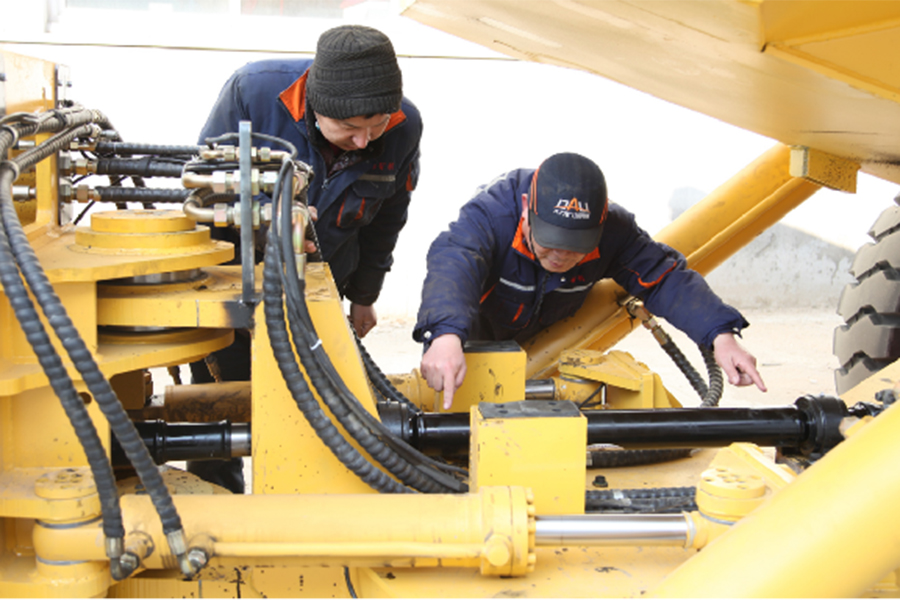Safety measures for maintenance of scooptram

The maintenance of the scooptram requires following safety measures to ensure the health of the operator and nearby staff.
1. Warning: Incorrect maintenance or repair methods may cause injury or death accidents. If you do not understand a certain operating procedure, repair method, or adjustment method, you can consult the sales company or dealer for more relevant information.
2.When repairing equipment, the “non operable” sign should be placed on the steering wheel or control device in the cab. If necessary, remove the engine key.
3. Do not make any unauthorized modifications to the device. When drilling, cutting, or welding operations, approval from the sales company or distributor should be obtained first.
4. Before carrying out repairs, always wear appropriate protective equipment, such as masks, safety shoes, thickened gloves, etc.
5. When using a hammer, an eye mask or face mask should be worn, as debris or gravel may cause damage to the eyes. When rotating a pin that is too tight, use a nylon or plastic hammer.
6. DANGER: If maintenance must be carried out under the equipment, always keep the parking brake in a braking state and secure the front and rear wheels.
7. Attention: Do not be in the articulated part of the vehicle body unless the hinge lock rod is installed first.
8. Maintenance should be carried out in a safe area with a stable roof and good ventilation, away from traffic arteries. The equipment must be parked on a flat surface. Before starting maintenance and repair, ensure that the wheels are fixed.
Attention: Before maintenance of the articulated parts of the vehicle body, the following points should be achieved first:
(1) Ensure that the articulated (swing) locking rod is installed between the loading and unloading frame and the power frame to prevent the two parts from rotating;
(2) If possible, remove the key from the OFF/ON/START switch and place a “non operable” sign;
(3) Turn the main power (battery) switch to the OFF position and hang a sign.
9. Before adjusting or repairing the engine or electric motor driven equipment, turn off the engine.
10. If maintenance must be carried out while the engine or electric motor is running, additional assistance is required. During the maintenance or adjustment process, the helper must be seated in the driver’s seat.
11.To prevent hearing loss, wear earplugs when repairing in a closed room with the engine running.
12. Warning: When handling the hydraulic system, all pressure should be released first.
13.When checking the leakage of high-pressure hydraulic equipment, cardboard or white paper should be used to determine the leakage point.
14. Attention: When equipment is found to be working abnormally or malfunctioning, it should be immediately shut down and properly inspected, and simple problems should be dealt with by oneself in a timely manner. If it is necessary to keep the equipment in a powered on state during inspection or maintenance, one person should operate the equipment and the other person should conduct the inspection. It is not allowed to inspect the equipment alone without stopping the machine.
15. Keep arms and body away from leakage points. If liquid enters the skin, it should be promptly removed and treated with medical attention.
Attention: Immersion of hydraulic fluid into the skin can cause injury or death accidents.
16. Warning: Stay away from rotating or moving components.
17. Ensure that the protective cover of the rotating parts is reinstalled.
18. Do not work under an open hood unless the hood is securely secured by a support rod.
19. When necessary, protective goggles, protective clothing, safety helmets, dust covers, or other protective items should be worn. Insulate all connected and disconnected wires.
20. The compressed air pressure used for cleaning the machine shall not exceed 30 pounds per square inch (20 kPa). Wear protective masks and clothing.
21. Use appropriate tools to replace damaged maintenance facilities.
22.Before starting the equipment, any tools, excess wires, and other parts should be removed.
23. After completion, the locking rod should be lifted and the fastening pin installed.
24. Wipe off any oil spills.
25. Safely and properly dispose of waste oil pollution.
26. Place the oil cloth in a fireproof container and do not leave it in the engine.
27. Do not place flammable liquids or body close to the engine.
Danger: Flammable liquids near the diesel engine exhaust system pose a risk of ignition and explosion.
Warning: There is a risk of burns when approaching the exhaust pipe and muffler of the diesel engine.
28. Danger: Before working under a suspended boom or under a crane or hopper, the following operations should be carried out:
(1) Empty the bucket, and set up a parking brake device;
(2) Install a safety bar under the bucket and flip the bucket completely backwards;
(3) Turn off the engine;
(4) Set the position of the “on/off” switch;
(5) Secure the wheels.
Warning: Do not carry out repair operations without understanding the structure and system functions of the scraper components. Always refer to the maintenance manual.
Post time: Oct-13-2023






